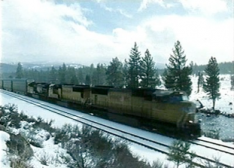RR by James Benning

RR (Benning, 2007)
Los Angeles Premiere! James Benning in person!
Chosen as one of the best movies of its year, and its decade, RR, by James Benning finally screens in Los Angeles. Filmforum begins its 2011 programming with this brilliant film, merging observation and motion, present-day commerce and the historical growth of America, in Benning’s inimitable style. James Benning will join us in person, and we hope you will as well for the start of Filmforum’s 36th year.
“Avant-garde? Documentary? Landscape study? At this point, it's better simply to call him one of America's greatest contemporary filmmakers, hands-down. RR, Benning's 2007 feature-length study of American railroads, is one of his finest achievements to date.” – Michael Sicinski
“Benning is easily one of the ten best visual thinkers working today, period. There's not a single redundant frame in the entire film: every shot finds a different angle/distance/composition. Sometimes scale is majestic; sometimes the train rushes up close in an epileptic blur of flashing colors; sometimes two trains overlap with such interlocking precision that, as ludicrous as it sounds, it's a Mamet-level shock.” – Vadim Rizov, Slant Magazine
#66 in Film Comment’s Best Films of 2000-2009
RR
Directed by James Benning (2007, 16mm, color, sound, 115 min.)
Benning’s last 16mm film, consisting of 43 static shots of trains crossing through the frame, in locations throughout the United States. The shot duration is determined by the time it takes the train to pass through the frame. “Looping, chugging and barreling by, the trains in Benning's latest monumental film map a stunning topography and a history of American development. RR comes three decades after Benning and Bette Gordon made The United States of America (1975), a cinematic journey along the country’s interstates that is keenly aware “of superhighways and railroad tracks as American public symbols.” A political essay responding to the economic histories of trains as instruments in a culture of hyper-consumption, RR articulates its concern most explicitly when Eisenhower's military-industrial complex speech is heard as a mile long coal train passes through eastern Wyoming. Benning spent two and a half years collecting two hundred and sixteen shots of trains, forty-three of which appear in RR. The locomotives' varying colors, speeds, vectors, and reverberations are charged with visual thrills, romance and a nostalgia heightened by Benning's declaration that this will be his last work in 16mm film.” – Harvard Film Archive “A mere description of Benning's process, however, utterly fails to convey the sensuousness and endless variety of his film. In the first shot in Utah, we see a train clear the screen to make way for cars and pedestrians. In shot 4, we see black tankers bisect a small-town street; shot 15 is a kind of prolonged, real-life magic trick I won't spoil. The landscapes, the colors, the distances, the close-up-blurs-to-extreme-long-shots that intentionally recall the Lionel HO-scale train sets of the 1950s and '60s — Benning's film invites us to spend time looking at a fundamental feature of our world, one from which car culture, Internet life, and our general discomfort with the smell, sound and perceived danger of the rails keeps us separate.“That "danger," of course, used to be the romance of the rails, the urge to hop a boxcar and see where it took you. Today, train enthusiasts set up folding chairs and "trainspot," identifying what's left of North America's rolling stock as a hobby. These rail fans were part of Benning's interest in making RR. But one of the reasons this film, and Benning's work more generally, commands interest beyond the avant-ghetto is the fact that what he is showing us — these trains — are objects functioning at the junction of film form and political economy….We're seeing capital in motion, and, just as often, stopping dead in its tracks.“RR is a film that requires a degree of patience and an adjustment of customary viewing strategies. But its rewards for that adjustment — and its implications as both an aesthetic experience and social document — are staggering.” – Michael Sicinski, Nashville Scene
